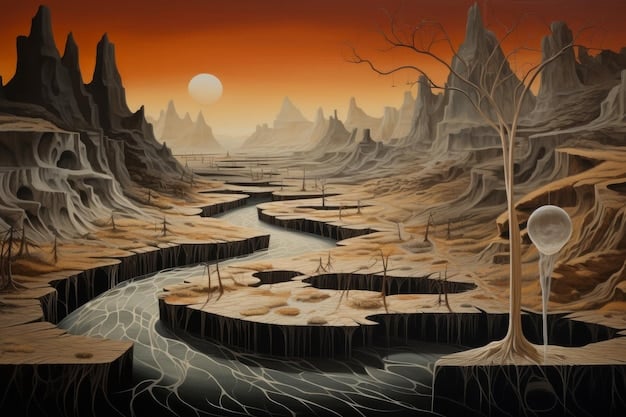Discovering the Genius of Paul Nash: A Forgotten Masterpiece in Art

Paul Nash, a British artist often overlooked, uniquely blended surrealism and modernism to capture the haunting beauty and trauma of war-torn landscapes, leaving a lasting impact on British art history.
Dive into the world of Paul Nash, a visionary British artist whose poignant landscapes and surrealist imagery deserve a closer look. Through his art, Nash captured the essence of a transforming world, offering a powerful reflection on nature, war, and the human condition.
Paul Nash: An Introduction to a Visionary Artist
Paul Nash was more than just a painter; he was a visionary who blended modernism with surrealism to create deeply evocative works. Born in 1889, Nash lived through periods of intense change and conflict, which heavily influenced his artistic perspective. This section will explore Nash’s early life and influences, setting the stage for understanding his unique contributions to the art world.
From his early idyllic landscapes to his later haunting depictions of war, Nash’s art reflects a sensitivity to the world around him. Throughout his career, he experimented with various styles and techniques, consistently pushing the boundaries of artistic expression.
Early Life and Artistic Beginnings
Paul Nash’s journey as an artist began with a deep connection to the English countryside. Growing up in Buckinghamshire, he developed a profound appreciation for nature, which would later become a central theme in his work. His early artistic endeavors were characterized by detailed and romantic landscapes.
Nash studied at the Slade School of Art, where he was exposed to the avant-garde movements that were reshaping the art world. Although he initially struggled to find his unique voice, this period was crucial in shaping his artistic identity.
- Childhood Influences: Nash’s early fascination with nature significantly shaped his artistic sensibilities.
- Artistic Training: His time at the Slade School of Art exposed him to new ideas and techniques.
- Early Works: His initial landscapes reflected a romantic and idyllic view of the world.

Nash’s early life and artistic beginnings laid the foundation for his later explorations of more complex themes. His deep connection to nature, combined with his exposure to modern art movements, prepared him to become one of the most important British artists of the 20th century.
The Impact of War on Nash’s Art
World War I had a profound impact on Paul Nash, both as a person and as an artist. Serving as an official war artist, he witnessed firsthand the horrors of trench warfare, experiences that would forever alter his artistic expression. This section will delve into how the war shaped Nash’s vision and the themes he explored in his war-related artwork.
His war paintings are not merely depictions of battles; they are powerful statements about the dehumanizing effects of conflict and the destruction of the natural world. Nash’s art served as a form of protest and a means of bearing witness to the unimaginable suffering of war.
Official War Artist
As an official war artist, Nash was tasked with documenting the realities of the Western Front. However, his experiences transcended mere documentation; he sought to capture the emotional and psychological impact of the war on the soldiers and the landscape.
His paintings from this period are characterized by their stark imagery, distorted forms, and muted colors, conveying a sense of desolation and despair. Nash’s unique artistic vision allowed him to transform scenes of destruction into hauntingly beautiful and deeply moving works of art.
- First-Hand Witness: His role as a war artist provided him with direct exposure to the horrors of war.
- Emotional Impact: The war profoundly affected his emotional and psychological state.
- Artistic Transformation: His artistic style shifted to reflect the harsh realities of war.
Nash’s war art remains a powerful testament to the human cost of conflict. His ability to capture the desolation and despair of the war-torn landscape solidified his place as a significant voice in British art history.
Surrealism and Landscape: Nash’s Unique Blend
Paul Nash’s artistic innovation lies in his unique blend of surrealism and landscape painting. Inspired by the surrealist movement, Nash sought to explore the deeper, often subconscious, meanings behind the visible world. This section will detail how Nash combined these two seemingly disparate styles to create artwork that is both evocative and thought-provoking.
By infusing his landscapes with surrealist elements, Nash transformed ordinary scenes into dreamlike visions. His approach to surrealism was deeply personal, reflecting his own experiences, memories, and emotional states.
The Influence of Surrealism
Surrealism, with its emphasis on the irrational and the subconscious, provided Nash with a new way to express his inner world. He was particularly drawn to the movement’s exploration of dreams, symbols, and hidden realities.
Nash’s surrealist landscapes often feature unexpected juxtapositions, distorted perspectives, and symbolic imagery. These elements combine to create a sense of unease and mystery, inviting viewers to question their perceptions of reality.
- Exploration of the Subconscious: Nash used surrealism to delve into the depths of the human psyche.
- Symbolic Imagery: His paintings are filled with symbols that evoke deeper meanings.
- Unexpected Juxtapositions: He created a sense of unease by combining disparate elements.

Nash’s ability to seamlessly blend surrealism with landscape painting resulted in a body of work that is both visually stunning and intellectually stimulating. His unique approach cemented his reputation as a visionary artist who dared to venture beyond conventional artistic boundaries.
Key Themes in Paul Nash’s Artwork
Throughout his career, Paul Nash explored several recurring themes that provide insight into his artistic vision. These themes include the relationship between humanity and nature, the impact of war on the environment, and the search for spiritual meaning in a modern world. This section will examine these themes in detail, highlighting their significance in Nash’s overall body of work.
By delving into these themes, Nash invites viewers to contemplate the complexities of human existence and the profound changes that were shaping the modern world. His art serves as a mirror, reflecting both the beauty and the challenges of the 20th century.
Nature and Humanity
Nash had a lifelong fascination with nature, viewing it as both a source of inspiration and a reflection of the human condition. His landscapes often depict a delicate balance between the natural world and human intervention.
In his paintings, Nash explored the ways in which humans interact with and impact the environment, often highlighting the destructive consequences of industrialization and warfare. His art serves as a reminder of the importance of preserving the natural world.
- Balance and Harmony: Nash sought to capture the delicate relationship between nature and humanity.
- Environmental Impact: He addressed the destructive consequences of human actions on the environment.
- Spiritual Connection: Nash found spiritual meaning in the natural world.
Nash’s exploration of nature and humanity reflects his deep concern for the environment and his belief in the power of art to inspire change. His paintings serve as a call to action, urging viewers to protect the beauty and fragility of the natural world.
Notable Works and Their Significance
Paul Nash left behind a rich body of work, including several paintings that are considered masterpieces of British art. These notable works reflect his unique artistic vision and his ability to capture the essence of a transforming world. This section will examine some of his most significant paintings and their enduring importance.
From his early landscapes to his later surrealist compositions, each work offers a unique perspective on Nash’s artistic evolution and his profound engagement with the world around him. His paintings continue to resonate with viewers today, inviting them to explore the deeper meanings behind the visible world.
“We Are Making a New World”
Painted in 1918, “We Are Making a New World” is one of Nash’s most iconic war paintings. The artwork depicts a desolate landscape scarred by trench warfare, with fragmented forms and muted colors conveying a sense of destruction and despair.
The title of the painting is ironic, suggesting that the war is not creating a better world but rather destroying the existing one. The painting serves as a powerful indictment of the horrors of war and a poignant reminder of the human cost of conflict.
- Iconic War Painting: Represents the desolation and despair of trench warfare.
- Ironic Title: Questions the notion of progress through destruction.
- Enduring Significance: Remains a powerful statement about the human cost of conflict.
“We Are Making a New World” stands as a testament to Nash’s artistic vision and his ability to transform scenes of destruction into deeply moving works of art. His painting continues to challenge viewers to confront the realities of war and its lasting impact on the environment and the human psyche.
Legacy and Influence on Contemporary Art
Paul Nash’s artistic contributions continue to resonate with contemporary artists and art lovers alike. His unique blend of surrealism and landscape painting, combined with his exploration of profound themes, has left a lasting impact on the art world. This section will explore Nash’s legacy and his influence on contemporary art.
Nash’s work has inspired countless artists to push the boundaries of artistic expression and to explore new ways of representing the world around them. His paintings serve as a reminder of the power of art to challenge perceptions, provoke thought, and inspire change.
Impact on Future Generations
Nash’s influence can be seen in the work of many contemporary artists who explore themes of nature, war, and the human condition. His innovative approach to landscape painting has inspired artists to find new ways of representing the natural world.
His use of surrealist techniques has also influenced artists who seek to explore the subconscious and the hidden realities behind the visible world. Nash’s legacy lives on through the artists who continue to draw inspiration from his work.
- Inspiration for Contemporary Artists: His work continues to inspire artists today.
- Exploration of Key Themes: His influence is evident in the works of artists who explore nature, war, and the human condition.
- Innovation in Landscape Painting: He inspired new approaches to representing the natural world.
| Key Point | Brief Description |
|---|---|
| 🎨 Artistic Style | Blended surrealism and modernism with landscape painting. |
| 🕊️ War Impact | Horrors of WWI influenced themes of desolation and loss. |
| 🌳 Nature Theme | Explored the delicate balance between nature and humanity. |
| 🖼️ Notable Work | “We Are Making a New World” reflects the devastation of war. |
Frequently Asked Questions
▼
Paul Nash is best known for blending surrealism and modernism with landscape painting, creating unique and evocative works of art that captured the essence of the transforming world during his time.
▼
Serving as a war artist during World War I profoundly influenced Nash, leading him to depict the horrors and desolation of war in his paintings, reflecting the emotional and environmental devastation.
▼
Key themes in Nash’s art include the intricate relationship between humanity and nature, the severe impact of war on the environment, and the profound quest for spiritual meaning in a rapidly modernizing world.
▼
One of Paul Nash’s most notable works is “We Are Making a New World,” a poignant painting that starkly portrays the desolation and profound human cost of the First World War.
▼
Paul Nash’s art remains relevant today because it challenges viewers to contemplate human existence and the significant transformations of the modern world through the beauty and challenges reflected in his art.
Conclusion
Paul Nash remains a compelling figure in British art history, largely due to his capacity to integrate surreal elements with tangible landscapes. His legacy is secured by the impact of war on his art, alongside his deep exploration into the relationship between humanity and the environment, ensuring that his art continues to inspire contemplation and deeper understanding.





